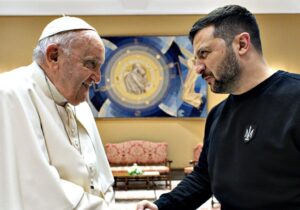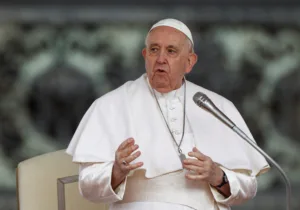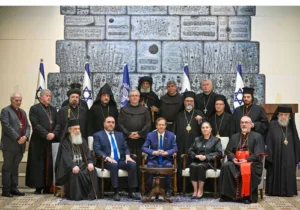The historical reputation of Pope Pius XII and his role in the Second World War have been disputed with passionate and often angry conviction since almost the time of his death. It is improbable that The Pope and the Holocaust will satisfy all parties involved in these debates. However, its author Michael Hesemann, a German scholar, ought to be acknowledged for the new facts he uncovers concerning the Pacelli papacy in the face of National Socialism, the German violation of Europe, and the systematic murder of six million Jews. It is written in the pope’s defense as unequivocally as Professor David Kertzer’s recent history of the same pontiff is presented as a prosecution brief. Mutually antagonistic as their perspectives are, the two authors are both beneficiaries of the disclosure of many previously unexamined resources in the Historical Archives of the Vatican State. Both works are painstaking in documentation, at moments even to the point of surfeit; Professor Kertzer, for instance, introduces on page six of his book a footnote in which he spells out for any who may be ignorant the correct pronunciation of the Italian duce. Both historians are visibly eager to leave an impression of having handled and weighed every item in the arsenal of relevant evidence.
Hesemann clarifies and contextualizes several important matters already apparent to those with any knowledge of the rulers of the Church and their diplomatic policies during the ascendancy of the Third Reich. One such fact is that while there have been any number of popes guilty of antisemitic prejudice, in times modern and ancient, Pius XII was not one of them. The record of his dealings with Jewish acquaintances and associates from adolescence onward is a consistent portrait of fraternal cordiality corroborated by the testimonies of Jew and Gentile alike. If anything surprises us, it is the notable absence in him of that bigotry which has crudely disfigured relations between Church and Synagogue since Pentecost, and which still thrived abundantly within Catholic officialdom during the early twentieth century. Pacelli was neither a promoter of racial hatred nor the unofficial chaplain of Hitlerism, as one of his previous biographers would have us believe, and the present work does good service in dismembering this particular fabrication. Hesemann rightly underscores the widespread disappointment within the Nazi government at the news of Pacelli’s election to the papal throne; Goebbels recorded in his diary that Hitler considered the election an act of deliberate antagonism toward Germany. The propaganda chieftain’s own opinion of Pacelli was that he was “totally against us…a liberal and a democrat.” Among the main organs of the Nazi press, the editors of one newspaper solemnly pronounced prior to the papal conclave of 1939 that “Cardinal Pacelli is a full Jew.” As for Pacelli’s views on Fascism, he summarized the doctrines of new German nationalism in a letter to a curial official as representing “perhaps the most dangerous heresy of our time.” He wrote this in 1924, a year before the appearance of Mein Kampf and a decade before Hitler’s appointment as chancellor, the Enabling Act, and the Nuremburg Race Laws. Between the Fuhrer and the pope there existed not the least affinity, either of ideology or of temperament. Every student whose mind is not governed by a parti pris in these concerns should recognize as much.
The relative scarcity of the pope’s wartime statements on the crimes of the fascist regimes is naturally examined at some length. His famed silence has often been raised against his memory by critics who draw from it the conclusion that the pope approved of, or was at best indifferent to the sufferings of the helpless millions who were the victims of the Final Solution: qui tacet consentire videtur. This conclusion is less plausible than it might at first appear. Pope Pius’ political instincts were largely formed during his many years in the Vatican Secretariat and Apostolic Nunciature. Before his elevation to the papacy, he was a seasoned diplomat, with a diplomat’s natural reserve combined with a private lack of self-assertion bordering on diffidence. He had become acquainted with the condition of the Catholic minority within the Ottoman Empire during the worst period of the anti-Christian pogroms of the First World War. Monsignor Angelo Dolci, Pacelli’s senior colleague and the apostolic delegate in Constantinople, had made the most of his limited powers to secure the protection of his coreligionists within Turkish domains.
His efforts, as he soon discovered, were fruitlessly spent. If anything, the position of the Ottoman Catholics may have been further compromised by his perseverance on their behalf, which consideration he related to Pacelli in a letter of 1915. Later, during the summer of 1942, Archbishop de Jong of Utrecht openly denounced the deportation of Dutch Jews in a widely publicized pastoral letter, an action which provoked immediate and infamous reprisals from the Nazi authorities throughout Holland. In a passage whose suggestions are tenable, if speculative, Hesemann implies that the pope felt that the urge to speak out dauntlessly on behalf of the Jews may itself have been “a devilish temptation to purchase for himself the praise of civilized nations and of posterity with the blood of all those additional innocent persons.” As T.S. Eliot wrote, “The last temptation is the greatest treason / To do the right deed for the wrong reason / For those who serve the greater cause / Make the cause serve them.”
Neither was the pope the only one to suffer misgivings as to the results that a direct condemnation of the pogroms would likely produce. The same dread was felt, with more immediate intensity, within prisoners’ barracks of the concentration camps. Hesemann illustrates this by a quotation from the memoirs of Fr. Jean Bernard, a Luxembourgish priest interned at Dachau: “The detained priests trembled every time news reached us of some protest by a religious authority, but particularly by the Vatican. We all had the impression that our warders made us atone heavily for the fury these protests evoked.”
On a final note, greater weight ought to be allowed to a fairly obvious fact often consigned to the margins by more than one writer who has dealt with the Pacelli pontificate, namely, that he lived within Fascist territory for nearly the whole of the war, and his capacity to maneuver on behalf of the victims of Fascism was necessarily restricted. This aspect of the historical situation often seems to be undervalued.
No authority or institution in this world ought to stand outside the range of moral assessment, and the office of St. Peter and his successors is no exception to the rule. Yet, in the case of Pius XII, a significant deal of what has been published has taken the form of calumny masquerading as honest criticism. Hesemann’s book provides something in the way of a gratifying rebuttal against the worst of these vituperations.






 Sponsor a student for Christianity & National Security 2024
Sponsor a student for Christianity & National Security 2024